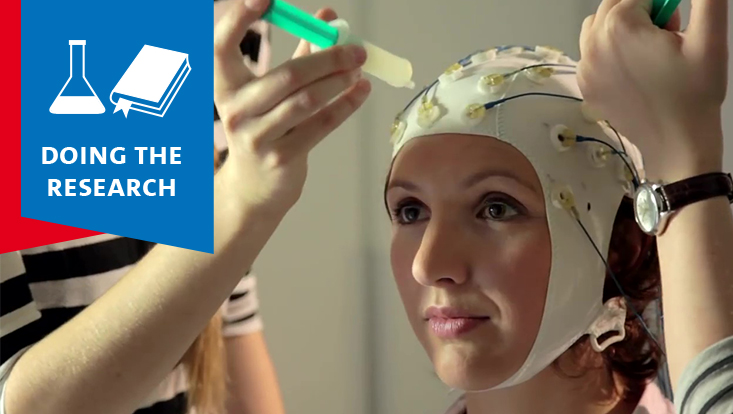Psychological research in the TrackingMinds project“People can learn surprisingly well how to judge others.”Doing the Research series
12 December 2022, by Anna Priebe

Photo: Universität Hamburg
What meaning do humans attach to the behavior of others? The TrackingMinds project team under the leadership of Prof. Dr. Sebastian Gluth in the research group Experimental Psychology are looking at how we estimate strangers and their decisions. In the interview below, Gluth explains how they research these processes and why some people are quick to say “yes.”
From observing another person and the processes in brain activity to the drawing of conclusions—how do you research something so complex?
One of the basic ideas of our project is that we human beings use our thinking systems, that we also use for making our own decisions, to interpret what other people do. We also presume that other people think the way we do. Previous research has shown, for example, that egotistical people see others as egotistical while people who are altruistic and share a lot expect others to behave similarly.
This is where our research begins and we conduct controlled lab experiments in which first the test subjects have to make decisions: they have X amount of money and they choose how to divide it between themselves and another anonymous person. In one case, they get more, in the other case, the anonymous person gets more. We first measure their behavior and assume that an egotistical person would choose to give him or herself more.
And that is the basis for what they believe another person would do?
Exactly. We then show test subjects the decision-making processes of other people and they should decide how egotistical or altruistic these other people are. They are already familiar with the task because they have performed it themselves. The important thing is that they receive different information. In part, they see what the other person chose; in part, however, only how long the person needed to make the decision.
Several situations need to be evaluated successively and we look at whether test subjects learn to judge the decision-making of other people and which factors or information they use and need to do so. Our data so far have suggested that people are surprisingly good at learning to judge others. That even works when you see how long a person needs to make a decision and not just what they chose.

You also use other methods, correct?
Yes. To better understand thinking processes in the brain at the level of neurons, we supplement our experiments with magnetic resonance tomography or EEGs. For example, here we see activating patterns in the brain when we make our own decisions and we can compare those with the signals when judging others. In this way, we want to find out whether test subjects mentally simulate the behavior of other people to interpret their decisions.
How should the findings be used later?
We are conducting basic research and the goal is, above all, to create a model of processes by which we judge strangers and anticipate their decisions. In the future, we would like to use this to develop a computer program that interacts with people and learns to improve the communication between people and machines. So far, machine learning is based, of course, on which decision is made at the end—A or B. But there is more information in our behavior and we would like to train AI such it can recognize and take into account these other factors.
The project is dynamic so we can add further questions.
Which factors might also be interesting?
In our project, we are looking for the first time at the decision-making time but of course there are other behavioral factors that are relevant. For example, we want to incorporate eye movements. They provide clues as to which information people even take on board. And because this kind of project is so dynamic, we could use the insights gained for further queries. Facial expressions, utterances such as sighs or other reactions could thus also be very interesting.
When you understand the processes behind the decisions it can also lead to manipulation, right?
Unfortunately, yes, and that is also interesting, of course, from this perspective. But in our project it is not important. This kind of research, decision-making neuroscience, is at the junction of neuroscience, psychology, and economics. In marketing, it could be interesting to make use of these findings, for example to determine a customer’s interest in a product based on the time the customer focuses on it and then specifically seeks it—even if the customer doesn’t buy it right away.
Does this research change they way you interact with people privately because you basically spend the entire time analyzing perceptions?
Now and then there are situations that attract my attention and I ask myself if I can use it. For example, when I play cards and I see how long the other player considers a move and whether that helps me determine how good the opponent’s card is.
When I want to explain why I research, I like to use the example of a wedding. When the bride and bridegroom are asked to say “I do,” the speed with which the “I do” is uttered is significant. If there is hesitation, the observer immediately asks if the person is uncertain. But I was also at a wedding where the bride basically said “I do” before the presiding official had even asked the question. You need to know that people are definitely attuned to the fact that their reaction time is being observed and they use it for so-called “signaling,” that is the quick decision sends a signal about how certain they are.
EU funding for TrackingMinds
Prof. Dr. Sebastian Gluth has been a professor at the Faculty of Psychology and Human Movement Science since 2020. He is also part of the emerging field Neurosciences and Cognitive Systems and the profile initiative Mechanisms of Change. The European Research Council (ERC) is funding TrackingMinds to the tune of €1.5 million through 2025 as part of a Starting Grant.
Doing the Research
There are approximately 6,200 academics conducting research at 8 faculties at Universität Hamburg. Many students also often apply their newly acquired knowledge to research practice while still completing their studies. The Doing the Research series outlines the broad and diverse range of the research landscape, and provides a more detailed introduction of individual projects. Feel free to send any questions and suggestions to the Newsroom editorial office(newsroom"AT"uni-hamburg.de).


